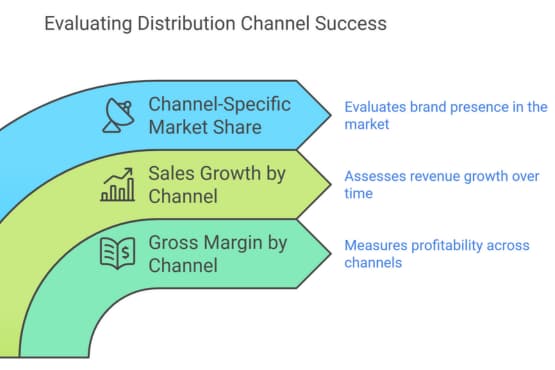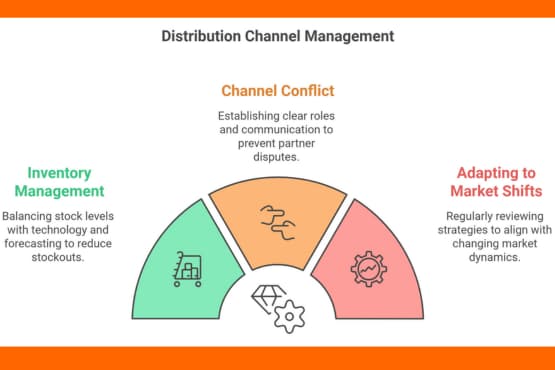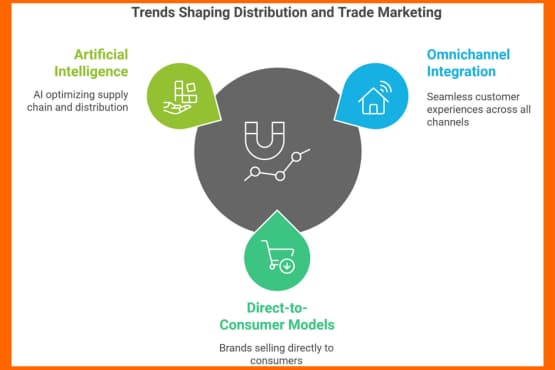Did you know that companies with optimized distribution channels can increase their market share by up to 35%? In the ever-evolving world of trade marketing, understanding the crucial role of distribution channels has become more important than ever.
This comprehensive guide offers a deep dive into the strategic importance of distribution channels, their impact on market reach, and proven optimization techniques to elevate your trade marketing efforts in 2024 and beyond.
By the end of this guide, you’ll have a clear roadmap for leveraging distribution channels to drive growth and profitability for your business.
Key Takeaways
- Distribution channels are strategic tools for driving growth and visibility
- Aligning trade marketing with distribution is key to maximizing the impact
- Diverse distribution strategies can significantly expand market reach
- Optimization requires ongoing analysis, adaptation, and integration with emerging trends
- Effective channel management involves clear strategy, strong partner relationships, and agility
Why Distribution Channels Matter
Distribution channels serve as the vital link between your products and your customers. But these channels are more than just a means of getting your products onto shelves – they’re a strategic tool for driving growth, enhancing visibility, and boosting your bottom line.
Consider this: A recent study found that companies with a well-executed multi-channel distribution strategy experienced a 15% increase in revenue compared to those relying on a single channel.
This highlights the immense potential of optimizing your distribution channels to gain a competitive edge.
Types of Distribution Channels:
To effectively leverage distribution channels, it’s crucial to understand the different types and their specific strengths. Let’s dive into a comparative analysis of the main distribution channels:

| Channel Type | Definition | Pros | Cons | Examples |
|---|---|---|---|---|
| Direct | Manufacturers sell directly to consumers |
|
|
|
| Indirect | Involves intermediaries such as wholesalers and retailers |
|
|
|
| Hybrid | Combination of direct and indirect channels |
|
|
|
Real-World Examples:
- Warby Parker: This eyewear brand disrupted the industry with its innovative D2C model, combining online and offline channels to offer customers a unique, convenient experience.
- LocalFoods: This small, regional grocery chain optimizes its limited distribution channels by partnering with local farmers and suppliers, creating a strong community connection and reducing supply chain costs.
Practices for Aligning Trade Marketing
To maximize the impact of your distribution channels, aligning them with your broader trade marketing strategy is essential.

Here are the core functions of trade marketing within distribution channels and best practices for each:
- Collaborative Planning with Channel Partners
- Develop joint business plans that align goals and incentives
- Regularly review performance and adjust strategies as needed
- Best Practice in Action: PepsiCo conducts quarterly business reviews with its key distributors to assess performance, share insights, and collaboratively plan for the upcoming quarter.
- Targeted Trade Marketing Campaigns
- Create channel-specific promotions to drive sales and enhance visibility
- Leverage data analytics to optimize campaign timing and placement
- Best Practice in Action: Procter & Gamble uses advanced analytics to create targeted trade promotions for specific retailer channels, resulting in a 10% increase in sales during the promotional period.
- Incentive Programs for Intermediaries
- Implement reward systems that motivate partners to prioritize your products
- Offer training and support to help partners effectively sell your products
- Best Practice in Action: Microsoft offers its channel partners a tiered incentive program based on sales performance and customer satisfaction scores, encouraging partners to deliver exceptional service.
- Data Sharing and Market Feedback
- Establish processes for regularly sharing sales data and market insights with channel partners
- Use feedback from partners and customers to inform product development and marketing strategies
- Best Practice in Action: Unilever has a robust data-sharing platform that allows its distributors to access real-time sales data and consumer insights, enabling better decision-making and collaboration.
Practices for Aligning Trade Marketing and Distribution
- Foster open communication and trust with channel partners
- Use data-driven insights to guide decision-making
- Continuously monitor and adapt to changes in the market and consumer behaviour
Maximizing Market Reach :
The right distribution channel strategy can significantly expand your market reach and boost product visibility.

Let’s look at some compelling cross-industry examples:
| Industry | Company | Distribution Strategy | Impact |
|---|---|---|---|
| Consumer Electronics | Samsung |
|
|
| Beauty and Personal Care | Sephora |
|
|
| Food and Beverage | PepsiCo |
|
|
Case Study: Samsung’s Adaptive Distribution Strategy
Samsung’s distribution strategy has evolved to keep pace with changing market dynamics and consumer preferences.
In the early 2000s, the company relied heavily on retail partnerships to expand its reach. However, as e-commerce grew, Samsung invested in its online presence, creating a robust direct-to-consumer channel.
Today, the company employs a hybrid approach, leveraging retail partnerships, online sales, and selective direct distribution to maximize its market reach and adapt to local market conditions.
Emerging Trend: Hybrid and Digital-First Distribution Models
Many companies are pivoting to hybrid or digital-first distribution models as consumer behaviour shifts towards digital channels.
For example, Nike has been investing heavily in its direct-to-consumer digital sales channel, while also maintaining strategic partnerships with key retailers.
This allows the company to have greater control over its brand experience while still leveraging the reach of traditional retail channels.
In a recent study, companies utilizing a multi-channel distribution approach reported a 35% increase in market share compared to those relying on a single channel. This highlights the power of diverse distribution strategies in driving growth.
Strategies for Distribution Channel Optimization
To get the most out of your distribution channels, follow these step-by-step optimization strategies:

- Conduct a Channel Performance Audit
- Analyze sales data, market share, and profitability by channel
- Identify areas of strength and opportunities for improvement
- Action Checklist:
- Gather sales data by channel for the past 12 months
- Calculate market share and profitability for each channel
- Identify top-performing and underperforming channels
- Action Checklist:
- Align Channels with Target Audience
- Evaluate channel preferences and behaviour of your target customers
- Prioritize channels that best reach and engage your core audience
- Action Checklist:
- Conduct customer surveys or focus groups to understand channel preferences
- Analyze customer demographics and buying behavior by channel
- Prioritize channels that align with your target audience’s preferences
- Action Checklist:
- Leverage Technology for Efficiency
- Implement digital tools for real-time inventory management and tracking
- Use data analytics to optimize product assortment and pricing by channel
- Technology Tips:
- Consider implementing an inventory management system like SAP or Oracle to improve visibility and efficiency
- Use data analytics platforms like Salesforce or Google Analytics to gain insights into channel performance and customer behaviour
- Technology Tips:
- Foster Strong Partner Relationships
- Establish clear communication channels and regularly share insights
- Collaborate on joint initiatives to drive mutual growth
- Action Checklist:
- Schedule regular check-ins with key channel partners
- Share performance data and insights with partners
- Develop joint marketing or promotional plans to drive sales
- Action Checklist:
By implementing these optimization strategies, businesses have seen up to 25% improvements in channel efficiency and sales growth.
Key Metrics
To gauge the effectiveness of your distribution channels, track these key performance indicators (KPIs):

- Gross Margin by Channel: Measure profitability by comparing revenue and cost of goods sold for each channel
- How to Calculate: (Revenue – Cost of Goods Sold) / Revenue
- Industry Benchmarks: According to a recent study, the average gross margin for consumer goods companies is 35-40% across channels.
- How to Calculate: (Revenue – Cost of Goods Sold) / Revenue
- Sales Growth by Channel: Assess year-over-year or quarter-over-quarter growth in sales revenue for each channel
- How to Calculate: (Current Period Sales – Prior Period Sales) / Prior Period Sales
- Channel-Specific Market Share: Evaluate your brand’s market share within each distribution channel
- How to Calculate: Your Brand’s Channel Sales / Total Channel Sales of All Brands
- Industry Benchmarks: Aim for a 10-15% market share within each key distribution channel to establish a strong presence.
- How to Calculate: Your Brand’s Channel Sales / Total Channel Sales of All Brands
Overcoming Challenges
Effective distribution channel management often comes with its fair share of challenges.

Here are some common issues and actionable solutions:
- Inventory Management
- Challenge: Balancing stock levels to avoid stockouts or overstock
- Solution: Implement technology for real-time inventory visibility and AI-powered demand forecasting
- Real-World Example: ABC Apparel faced frequent stockouts during peak seasons, leading to lost sales and customer frustration. By implementing an AI-powered demand forecasting tool, the company reduced stockouts by 30% and improved customer satisfaction.
- Channel Conflict
- Challenge: Competing interests or lack of coordination between channel partners
- Solution: Develop a clear channel strategy with defined roles and transparent communication
- Solution Framework:
- Clearly define each channel partner’s role and responsibilities
- Establish regular communication channels to share updates and resolve issues
- Implement a fair and transparent pricing and incentive structure across channels
- Solution Framework:
- Adapting to Market Shifts
- Challenge: Staying agile in the face of changing consumer behaviour and market dynamics
- Solution: Regularly review channel performance and consumer insights to identify shifts and adapt strategies
- Real-World Example: DEF Electronics noticed a significant shift towards online sales during the pandemic. By quickly adapting its distribution strategy to prioritize e-commerce channels, the company maintained its market share and even grew sales by 10% during the challenging period.
Pro Tip: Develop contingency plans for potential disruptions in your distribution channels. This can include diversifying your partner base or exploring alternative fulfilment options.
Emerging Trends
Several trends are shaping the future of distribution and trade marketing. Here are some key trends and how you can leverage them:

- Omnichannel Integration
- Trend: Consumers expect seamless experiences across online and offline channels
- Action: Develop a unified commerce strategy that integrates inventory, fulfilment, and customer data across channels
- Future-Proofing Tip: Start by mapping out your customer journey across channels and identifying key touchpoints for integration. Prioritize areas that have the most significant impact on customer experience and sales.
- Projected Timeline: Omnichannel integration is expected to become the norm within 3-5 years, with early adopters already seeing significant benefits.
- Direct-to-Consumer (DTC) Models
- Trend: Brands are increasingly bypassing traditional channels to sell directly to consumers
- Action: Evaluate the potential for a DTC channel to complement your existing distribution strategy
- Future-Proofing Tip: Conduct a feasibility study to assess the potential ROI of a DTC channel. Consider factors such as target audience preferences, product suitability, and logistics capabilities.
- Projected Timeline: DTC models are rapidly gaining traction, with many brands expected to launch or expand their DTC channels within the next 1-2 years.
- Artificial Intelligence (AI) and Automation
- Trend: AI is transforming supply chain management and distribution
- Action: Explore how AI-powered solutions can optimize inventory management, demand forecasting, and channel performance
- Future-Proofing Tip: Identify key areas where AI can drive efficiencies and improve decision-making. Pilot AI solutions in a controlled environment before scaling across your distribution network.
- Projected Timeline: AI adoption in distribution is expected to accelerate rapidly, with most companies leveraging AI-powered solutions within the next 3-5 years.
By staying attuned to these emerging trends and proactively adapting your strategies, you can position your brand for success in the evolving landscape of distribution and trade marketing.
Conclusion:
Distribution channels are a powerful lever for driving growth and profitability. By understanding the strategic role of different channel types, aligning them with your broader marketing goals, and continuously optimizing performance, you can unlock new levels of success for your brand.
As the renowned management consultant Peter Drucker once said, “Marketing aims to know and understand the customer so well that the product or service fits him and sells itself.” By leveraging the power of distribution channels, you can ensure that your products reach your customers and sell themselves.
To put your distribution channel strategy into action, follow these steps:
- Analyze your current channel mix and identify areas for optimization
- Align your channel strategy with your target audience and broader marketing goals
- Implement technology solutions for efficiency and data-driven decision-making
- Foster collaborative relationships with channel partners
- Stay agile and adapt to emerging trends and shifts in the market
Pro Tip: Remember, your distribution channel strategy is not a one-time exercise. Continuously monitor performance, gather insights, and adapt your approach to stay ahead of the curve.
By leveraging the insights and strategies in this guide, you’ll be well-equipped to harness the full potential of distribution channels in driving trade marketing success for your brand in 2024 and beyond.




